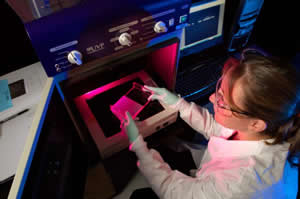Produce Strikes Back: Salmonella Saintpaul Outbreak
Posted July 3, 2008 by Ali S. Khan
 McDonald’s stopped serving sliced tomatoes on their burgers. Other businesses in the food industry have also recently joined this precautionary movement -- actions that follow a trail of health reports all over the United States in what has become one of the largest multistate outbreaks in history.
McDonald’s stopped serving sliced tomatoes on their burgers. Other businesses in the food industry have also recently joined this precautionary movement -- actions that follow a trail of health reports all over the United States in what has become one of the largest multistate outbreaks in history.
On May 22, 2008, CDC received notification from the New Mexico Department of Health and the Indian Health Service. They were investigating a cluster of illnesses: 19 people sick with symptoms of foodborne disease. Stool samples implicated a rare strain of Salmonella bacteria called Salmonella Saintpaul. The initial group of sick people was mostly composed of residents of New Mexico, but also included 2 from Arizona and 1 living in Utah. At the same time, 2 sick people in Texas and 1 in Colorado had also been separately identified. These seemingly dissimilar puzzle pieces were quickly connected thanks to the revolutionary public health tools called PulseNet and Outbreak.net. A team of local, state, and federal epidemiologists confirmed the connection on the basis that stool tests for the Salmonella bacteria from different sick people showed similar DNA patterns – like a fingerprint match. These findings suggested that all the illnesses were not only being caused by the same pathogen (Salmonella Saintpaul bacteria), but also coming from the same source.
Once this DNA-link between many of the persons becoming ill was confirmed, teams of epidemiologists and biostatisticians were launched into a wide-reaching and thorough investigation. The Goal: To identify the common thread between all the people becoming ill. In other words, if we could identify what each of these people had done that was the same, we could identify the source of the outbreak. All we knew was that whatever the vehicle was, it had been distributed to a wide geographic range. But this information alone wouldn't get us very far. Interviews that compared what ill and well-persons had recently eaten in Texas and New Mexico were designed and implemented. Initial investigation identified the consumption of large, uncooked, red tomatoes as the most likely source of illness for those studied in Texas and New Mexico (80% of those ill reported eating fresh tomatoes). The FDA became involved to test the tomatoes so that the spread of illness could be stopped at the source as quickly as possible. Laboratory tests to date, however, have been unable to locate any infected tomatoes, and additional studies are suggesting that the outbreak may not be due to tomatoes alone but also to something commonly mixed with fresh tomatoes as in salsa.
Two months of hard work by many state health departments, the FDA, the fresh produce industry and our CDC team here, have identified 922 persons infected with Salmonella Saintpaul, with the same genetic fingerprint, living in 40 states and the District of Columbia. The hunt for the cause continues…
For more information on the ongoing CDC investigation and FDA recommendations:
Comments
No comments posted.
Disclaimer: The content of Public Health Matters expresses the opinions of its authors and does not necessarily represent the views of the Centers for Disease Control and Prevention.
- Page last reviewed: July 3, 2008
- Page last updated: October 10, 2008
- Content source: National Center for Zoonotic, Vector-Borne, and Enteric Diseases
Contact Us:
- Centers for Disease Control and Prevention
1600 Clifton Rd
Atlanta, GA 30333 - 800-CDC-INFO
(800-232-4636)
TTY: (888) 232-6348
24 Hours/Every Day - cdcinfo@cdc.gov

